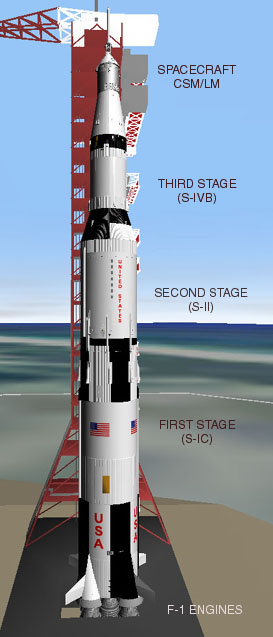|
>Orbiter Sim > Missions/Adventures >
Apollo Missions 
The manned missions of Apollo were launched off of Saturn V rockets with the
exception of Apollo 7. The Apollo 7 mission was a return to flight mission that place the astronuats in Earth orbit with a Saturn IB. The Saturn V rockets consisted
of three stages that would place the Apollo spacecraft in a parking orbit around Earth. From there the astronuats could head off to the moon with a small additional
burn from stage three. In space lingo terms this place them on there way by doing a translunar injection ( TLI ) burn. Once the Apollo spacecraft was on the translunar
trajectory stage three had finished doing its job and was discarded as were the first two stages previously. The whole assembly launched with five F-1 engines designated by the "V" in Saturn V.
The complete stacked assembly included the three rocket stages, the Service
Module (SM), the Command Module (CM), the Lunar Module (LM) and the emergency escape system. The Lunar Module had a decent stage as well as an ascent stage.
First Stage (S-IC):
GET: Lift off - 2.5 minutes
Altitude: 38 miles
Engines: Five F-1 engines
Second Stage (S-II):
GET: 2.5 minutes - 8.5 minutes
Altitude: 115 miles
Engines: Five J-2 engines
Third Stage (S-IVB): ( parking orbit )
GET: 8.5 minutes - 11.25
Altitude: 315 miles
Engines: One J-2 engines
Third Stage (S-IVB): ( translunar trajectory )
Engines: J-2 is reignited for translunar burn
Apollo 8
Travelling from the Earth to the Moon
Apollo 8 was launched from Launch Complex 39, Pad A, at the Kennedy Space Center, Florida. Liftoff occurred at a Range Zero time of 12:51:00 GMT (07:51:00 a.m. EST) on 21 December 1968.
Prior to lift-off
After the Apollo guidence computer ( AGC ) bootupcheck you can begin to use the Display & Keyboard ( DSKY ) interface to program.
*******************
DSKY: PGOG NOUN O1 ENTER ( Clears computer memory )
DSKY: VERB 33 ENTER ( to see more data )
*******************
Ascent Phase
If everthing goes well the auto-pilot will handle the flight and firing of the stages until reacing a parking orbit.
~ 2:50 Stage 1 sep
*******************
DSKY: NOUN 00 ENTER ( idle )
*******************
He is occupying the centre couch and has the task of monitoring the progress of the ascent by watching three computer displays
right in front of him. He has entered Verb 82, Noun 50, which changes the display from velocity, altitude rate and altitude, to one
that displays altitude, height of perigee (HP, its lowest point) and "Time of free fall".
~ 8:58 Stage 2 sep S-II cut-off. Having reached about 1.9 g, the five J-2 engines are shut down
~ 12:00 SECO (S-IVB Engine Cut-Off).
velocity now, 25,577 feet per second [7,796 m/s].
perigee of 181.5 km (98.0 nautical miles) and an apogee of 191.3 km (103.3 nautical miles) and being so low, has a period of 88 minutes, 10 seconds
inclination 32.509°,
******************
Activate S-IVB ATTITUDE; ROLL PITCH YAW
******************
The J-2 engine on the aft end of the S-IVB stage is due to be restarted in a maneuver that will send Frank Borman, Bill Anders
and Jim Lovell further away from the Earth than any human has ever ventured. This is the TLI or Translunar Injection maneuver.
The 317.72-second translunar injection maneuver (second S-IVB firing) was performed at 002:50:37.79. The S-IVB engine shut
down at 002:55:55.51 and translunar injection occurred ten seconds later, at a velocity of 35,505.41 ft/sec, after 1.5 Earth revolutions lasting 2 hours 44 minutes 30.53 seconds.
*****************
Calculate the TLI by using TransMFD (shift X), target the moon (shift T), Set HTO (shift X) to 317 seconds. This will display all the numbers you'll need to enter into the DSKY.
DSKY: VERB 37 NOUN 15 ENTER ( bla bla )
DSKY: VERB 22 ENTER [ +00020] ( sinc to twenty minutes )
When DTe counts down to twenty minutes (1200 sec) press PROG to update computer clock
DSKY: VERB 21 ENTER [ Dv ] example('+03143') then press PROG
The computer will now preform the TLI burn automatical and shutdown when done
******************
On panel 3 of the Main Display Console, a dual gauge shows the pressure in the fuel and oxidiser tanks for the SPS (Service Propulsion System) engine
7,793 m/s], showing an apogee of 105.5 nautical miles [195.4 km]; and our Translunar Injection burn will have the effect, here's that comm going up, let's catch up with it."
"Apollo Control back here. The TLI burn will add 10,500 feet per second - perhaps a foot or more per second, but that is pretty
close - 10,500 feet per second to the present 25,570. The duration of the burn will be slightly more than 5 minutes. It will occur 2 hours, and 50 minutes into the flight
At 002:49:15, these ullage motors begin firing for one minute, 16 seconds
The engine start command is sent at 002:50:29.51 GET. The restart sequence is essentially identical to the other J-2 starts except
that fuel is allowed to run through the engine walls for eight seconds before the final ignition
002:50:40 Lovell: Ignition.
Translunar Phase
Download NASSP to set up the historical Apollo environment.
|
